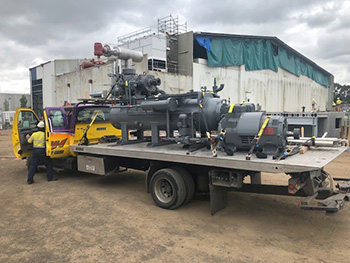The 2019 AIRAH Awards are being held on Thursday, November 14, and the finalists have been announced.
While some awards highlight a specific aspect or sector of HVAC&R, one category that cuts right across the industry is the Excellence in Innovation Award. This year the award is sponsored by Mitsubishi Electric.
The Excellence in Innovation award recognises outstanding examples of research results, knowledge and technologies that have been developed for the community, companies and government agencies.
“The finalists have contributed to our valuable knowledge pool, by improving on what has already been developed or have created truly something original,” says AIRAH CEO Tony Gleeson, M.AIRAH.
The finalists in 2019 are:
Arup
Barrack Place

Barrack Place is a new A Grade office building in the heart of the Sydney CBD designed to respond to the demand for buildings that are both environmentally conscious and healthy for occupants. The building has 6 star Green Star ratings for base build and for the Arup tenancy, and was the first building in Australia to be pre-certified platinum by the International WELL Building Institute.
The air conditioning design employs a range of innovative features including full underfloor supply to the low-rise floors, a supplementary natural ventilation system and enhanced health features designed in accordance with the WELL requirements.
“In most commercial buildings the selection of the air conditioning system is a one-size-fits-all approach,” says Arup’s Aimee Clark. “The design of Barrack Place demonstrates how significant enhancements can be made by taking into consideration the unique aspects of the architectural design arising from both base building and fit-out features.”
Scantec Refrigeration Technologies
Bidfood Mackay

This Queensland project saw an HFC-based cold store system replaced by a leading-edge low-charge ammonia system. Not only has the project made the facility more sustainable in terms of the refrigerants used, it has also reduced energy consumption by almost 60 per cent.
“This system is a unique Australian development,” says Scantec’s Stefan Jensen, F.AIRAH. “There are other centralised low-charge NH3 refrigeration system developments in the US and Europe, but none of these competing developments have the same installed base in terms of plant numbers as found in Australia.
“This development has the capacity to meet Australia’s unique challenges, and assist other hot jurisdictions in other parts of the world. Put simply, the technology has the capacity to transform Australia from being a technology taker to becoming a technology exporter.”
Alinta Energy Geothermal
Fairwater Geothermal Installation

Fairwater is a Frasers Property Australia community located in Blacktown in Sydney’s west.
It was the first project in NSW to achieve the highest rated 6 star Green Star Communities rating from the GBCA. Key to this achievement was the use of ground-source heat pumps. When completed, Fairwater will be the largest geothermal community in the southern hemisphere, with the technology accessible to all 800 homes onsite.
“Geothermal uses approximately 60 per cent less energy for heating and cooling and compared to an equivalent size house and power use, and can save residents up to $500 per annum,” says Mark Langdon, Alinta Energy Geothermal’s national sales manager.
Hoctor
The Big Freeze

Hoctor Refrigeration overcame challenges inherent to super-low-temperature systems in CO2 plant design to deliver Australia’s largest blast tunnel freezer. The innovations enable Australian Lamb Colac (ALC) to meet market demands for volume, quality and readiness.
“The project inspires confidence in natural refrigerants,” says Hoctor director James Hoctor. “This cascade tunnel – safely using ammonia and CO2 – reduced bottlenecks and delivered savings. It has tripled the plant’s freezing capacity and increased daily output from 3,312 to 7,632 lamb cartons per day.
“Freezing previously took 36–40 hours at -30 to-35°C and could not keep pace with abattoir processing. Meat cartons are now frozen in less than 24 hours because the improved system reaches -45 to -50°C.”
Bueno and Woolworths
Woolworths Energy Management Centre

As a considerable consumer of energy, and with one of Australia’s largest HVAC&R asset portfolios, Woolworths turned to data and analytics for its management solution.
Forming an embedded partnership with Bueno, the company built the Energy Management Centre (EMC). This merged existing facilities’ management systems with the latest in data and analytics technology. From infrastructure design and software development, through to installation and integration of over 6,500 sub-meters, the team connected over 1,000 sites nationally in under two years.
The EMC provides visibility and insights across the entire portfolio to optimise energy consumption. Insights generated through customised analytics highlight existing and potential energy optimisation opportunities, and have underpinned a 7.5 per cent reduction in energy consumption in FY19. The foundations built through the EMC are now enabling the wider Woolworths FM team to leverage data and analytics to reduce whole-of-life cost, deliver field force efficiencies and improve customer outcomes.
Winners of the AIRAH Awards 2019 will be announced at a presentation dinner held at Doltone House in Sydney on Thursday, November 14.
The feature image shows the winners of the 2018 Excellence in Innovation: A.G. Coombs and AECOM – International Convention Centre, Sydney.



Leave a Reply